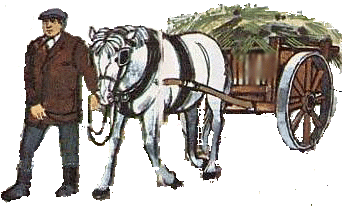|
|
Farmers were required
to pay a tax called a Tithe, this went to support the local church
of Ireland clergyman, most farmers were either Catholic or Presbyterian
so naturally resented this tax. There had been disturbances in the
eighteenth century, in 1830 matters came to a head again.In
Graiguenamanagh, Co Kilkenny some farmers asked the rector to reduce
the Tithe because the price they received for their produce had
fallen, he refused so they withheld payment totally. a head again.In
Graiguenamanagh, Co Kilkenny some farmers asked the rector to reduce
the Tithe because the price they received for their produce had
fallen, he refused so they withheld payment totally.
The only way he could get his income was
to to get the police to seize the farmers cattle and sell them.
The law stated that this could only be done during the hours of
daylight, and if the animals were not locked up. So the farmers
took to grazed the animals at night and locking them up during the
day. If some were seized no one would bid on them or supply fodder.
The campaign was successful and quickly spread
to other areas, the original organizers were the larger farmers,
priests and sometimes even landlords were involved, they tried to
keep it peaceful, but inevitably some secret societies became involved
and included rents as well as tithes, many threatening letters were
sent, these were quickly followed by beatings, burnings and murder,
the country quickly descended into chaos.
The government sent in troops to assist the
police in collecting the tithe. In one confrontation in Newtownbarry,
Co Wexford in 1831 fourteen people were killed. In 1832 only £12,000.00
was collected at a cost to the government of £26,000.00
|

 a head again.In
Graiguenamanagh, Co Kilkenny some farmers asked the rector to reduce
the Tithe because the price they received for their produce had
fallen, he refused so they withheld payment totally.
a head again.In
Graiguenamanagh, Co Kilkenny some farmers asked the rector to reduce
the Tithe because the price they received for their produce had
fallen, he refused so they withheld payment totally.